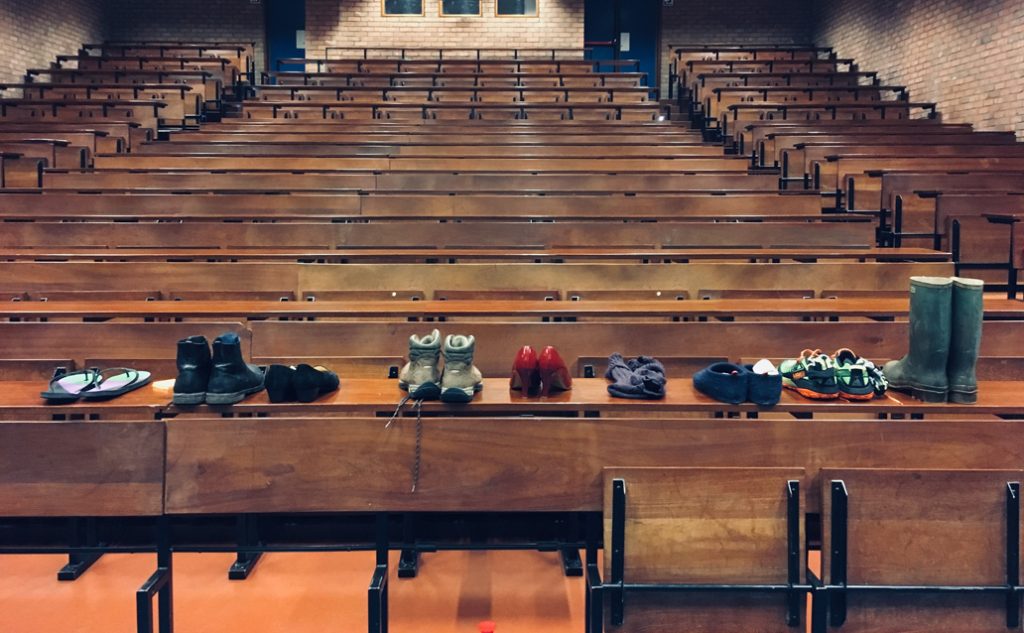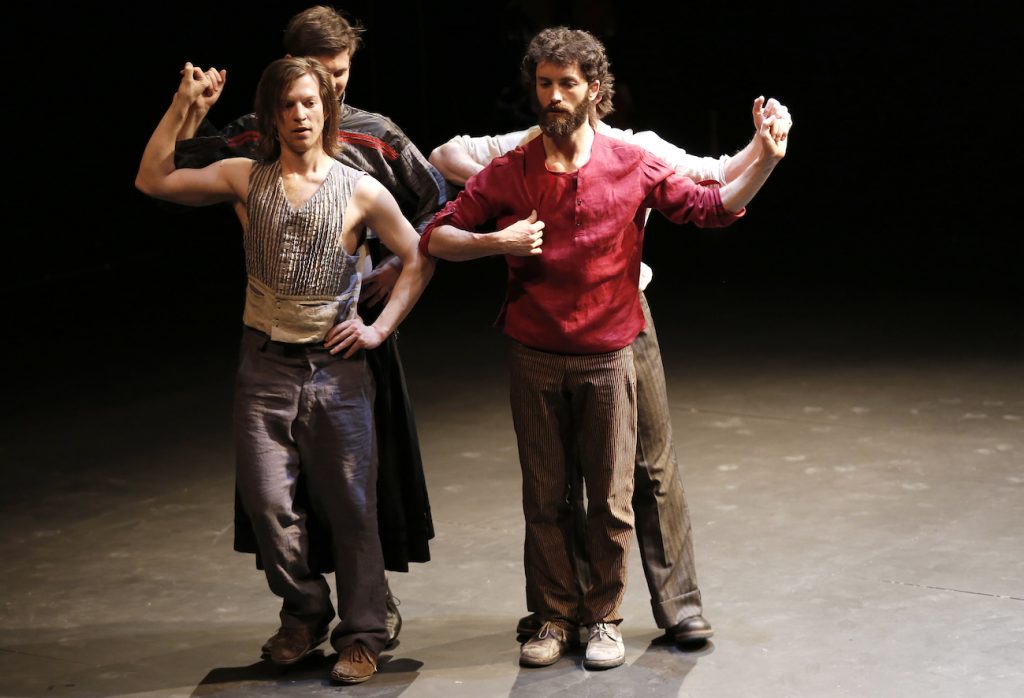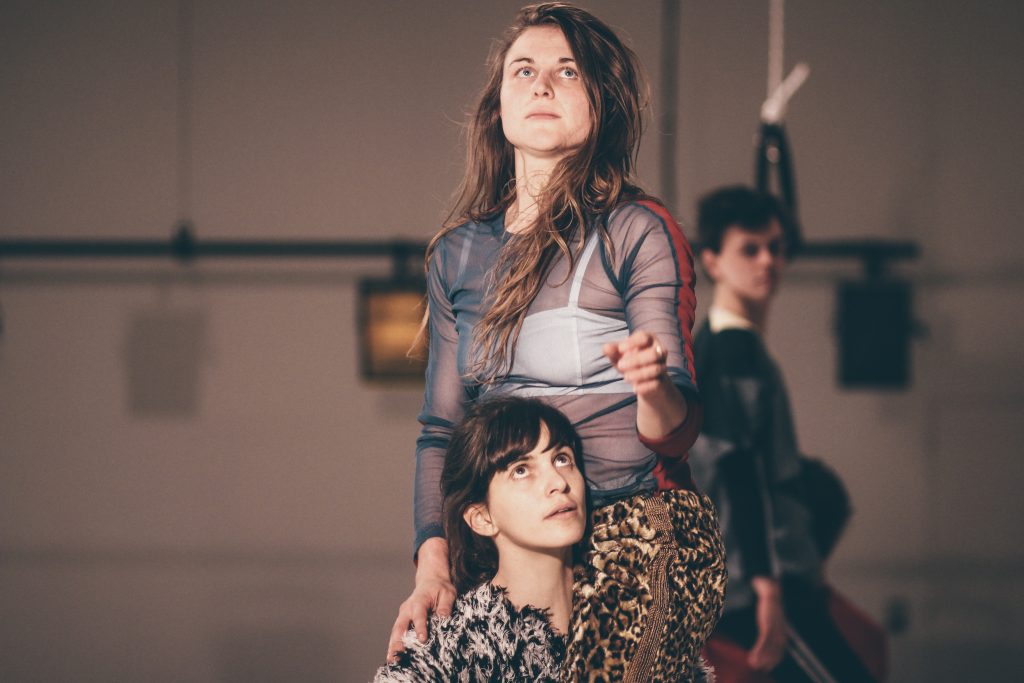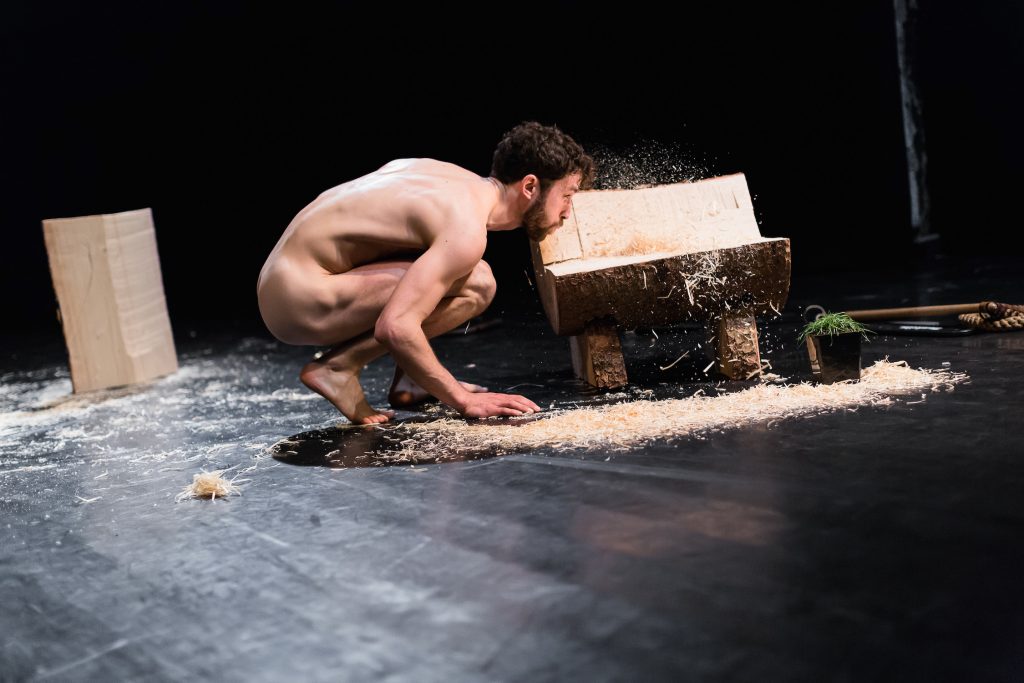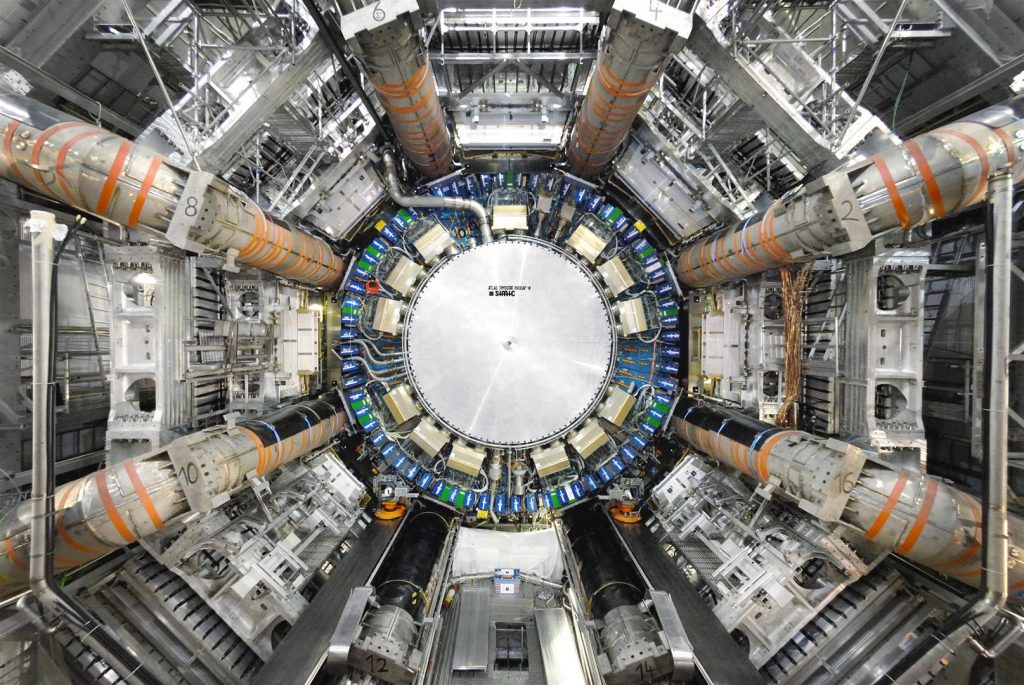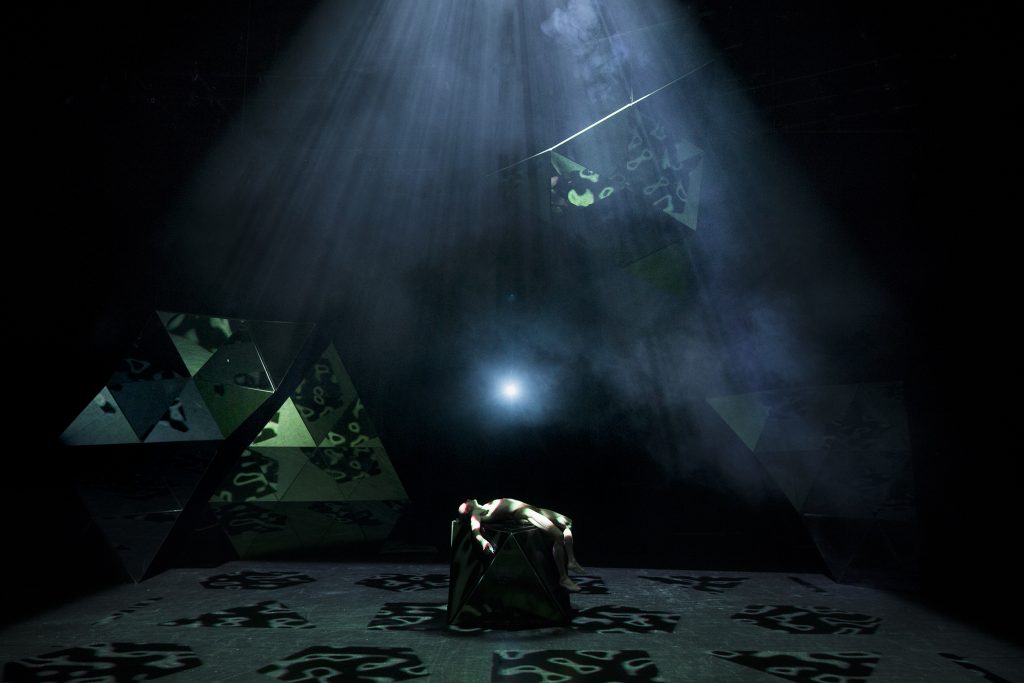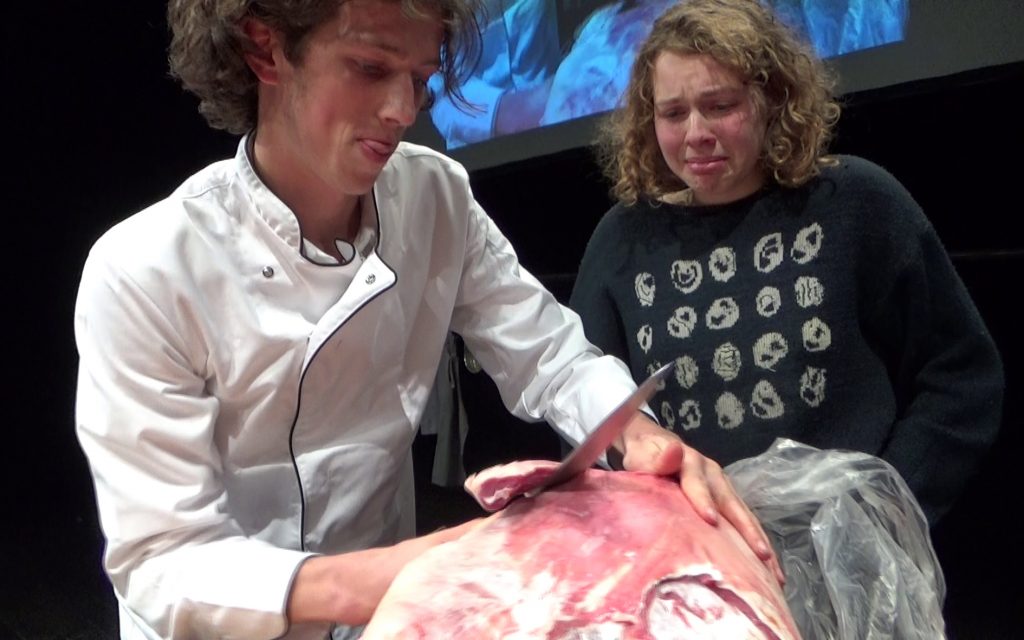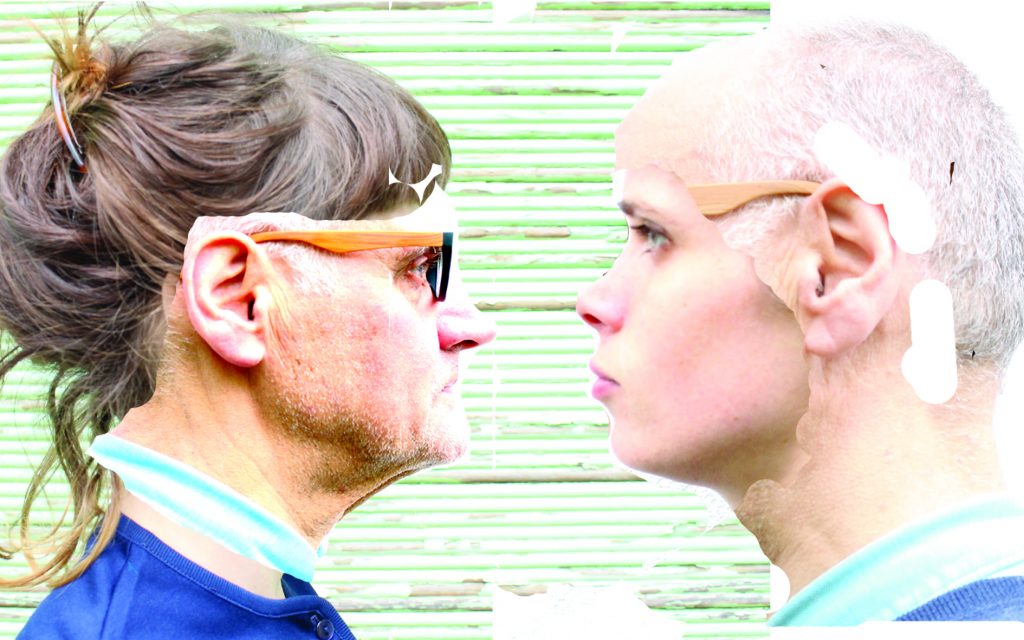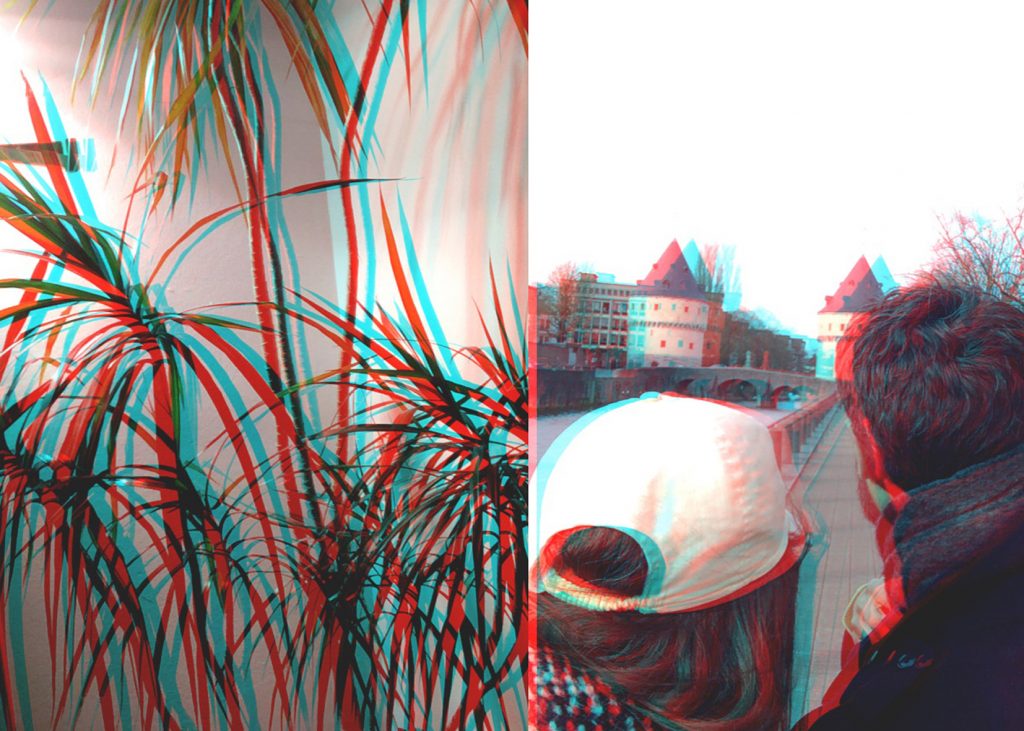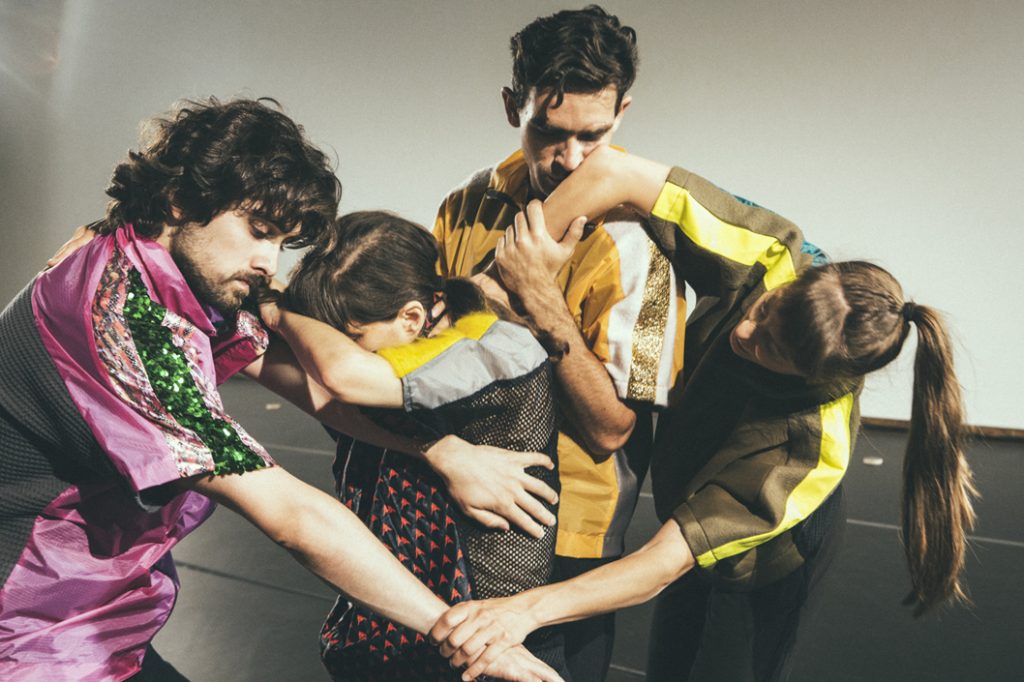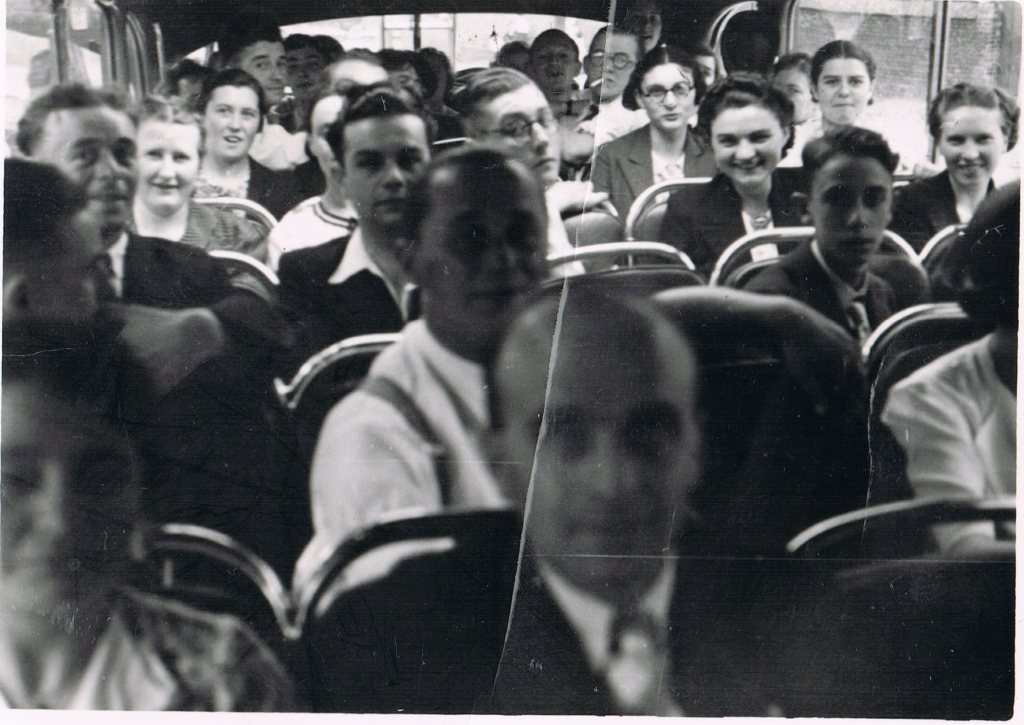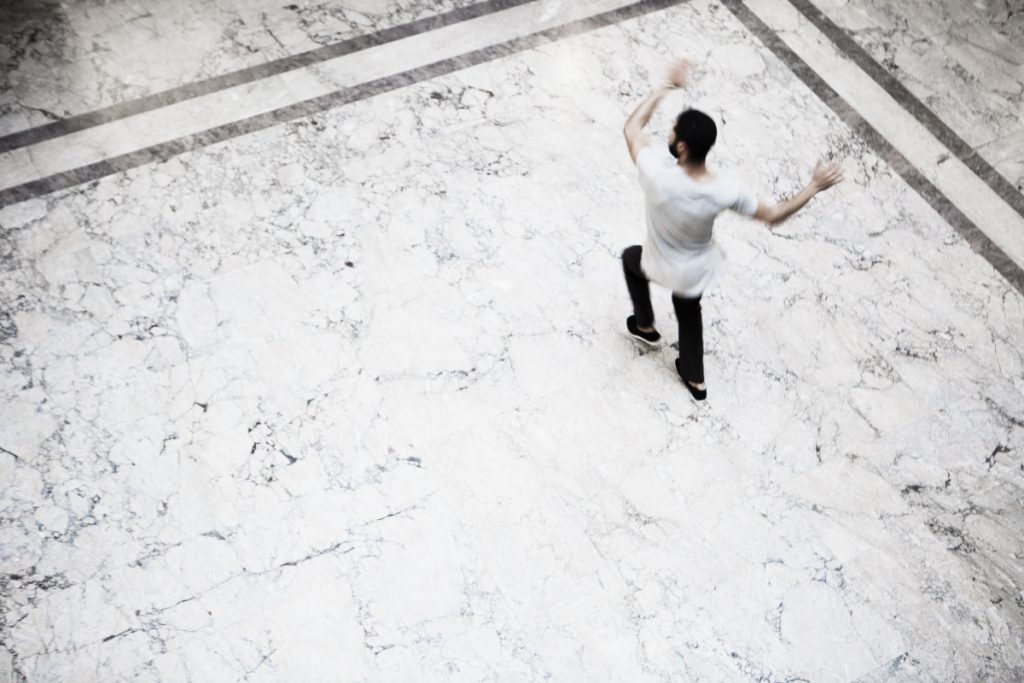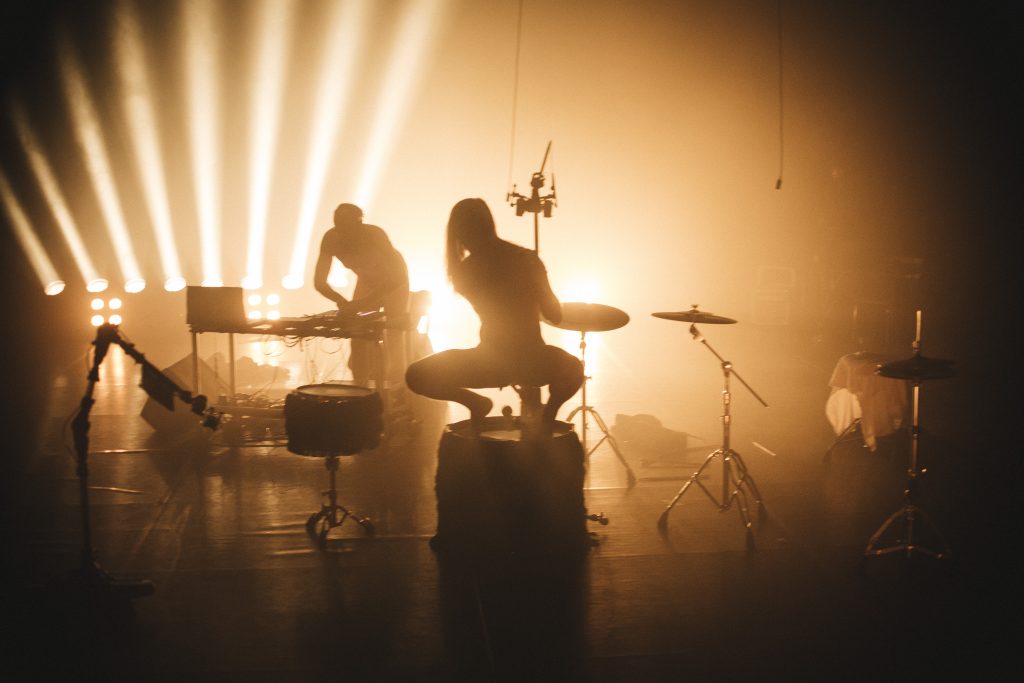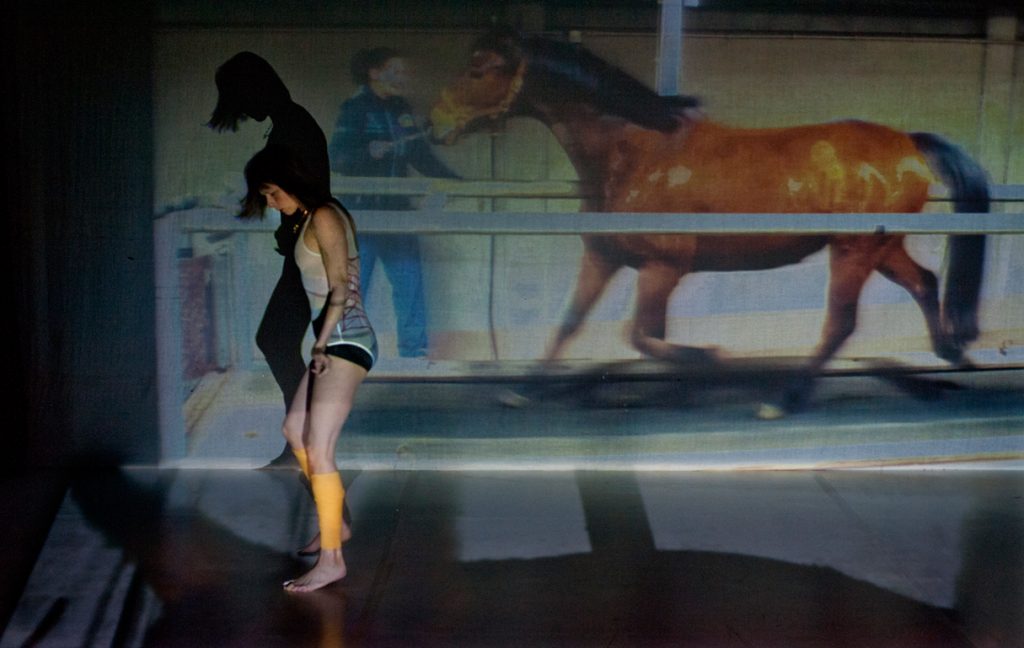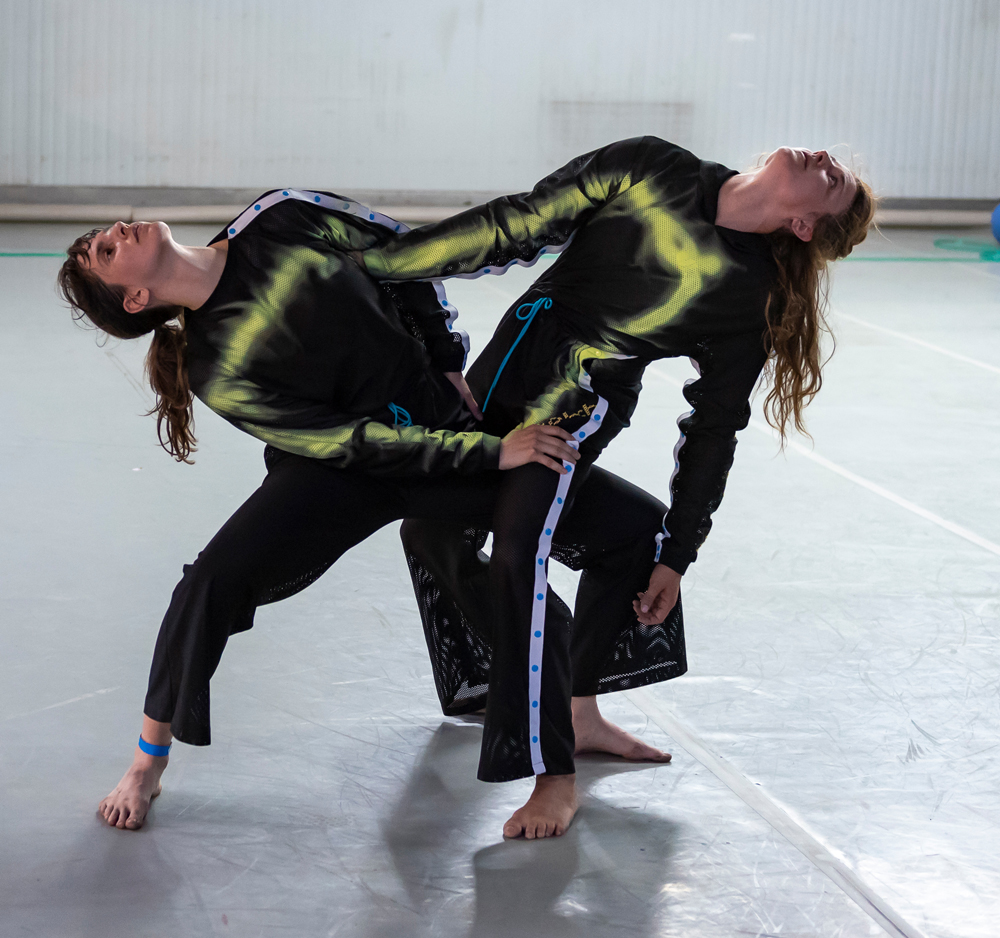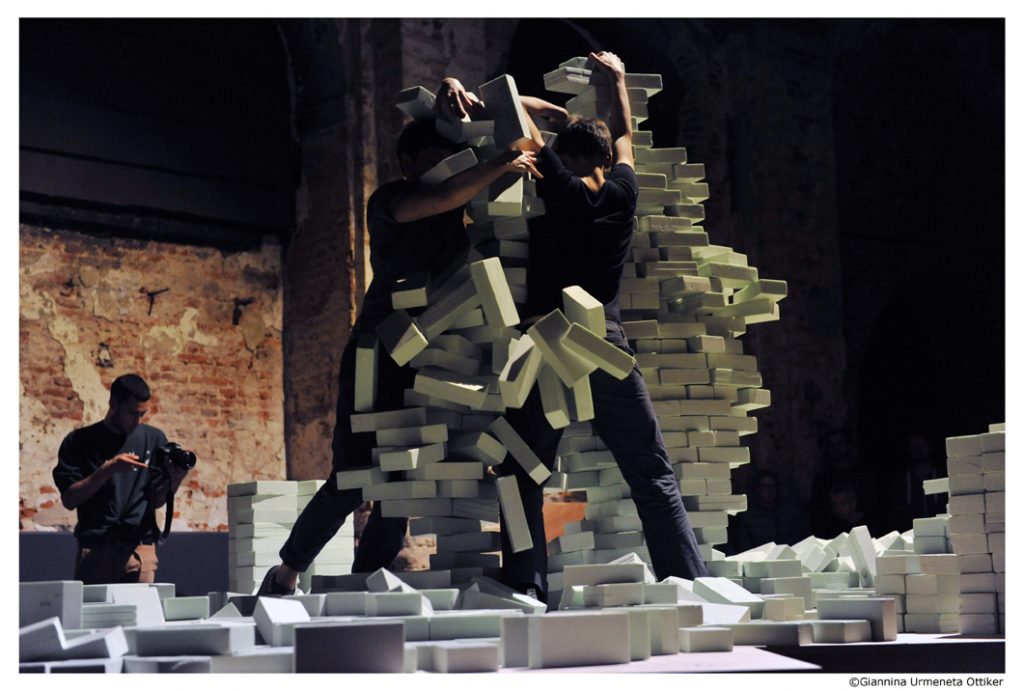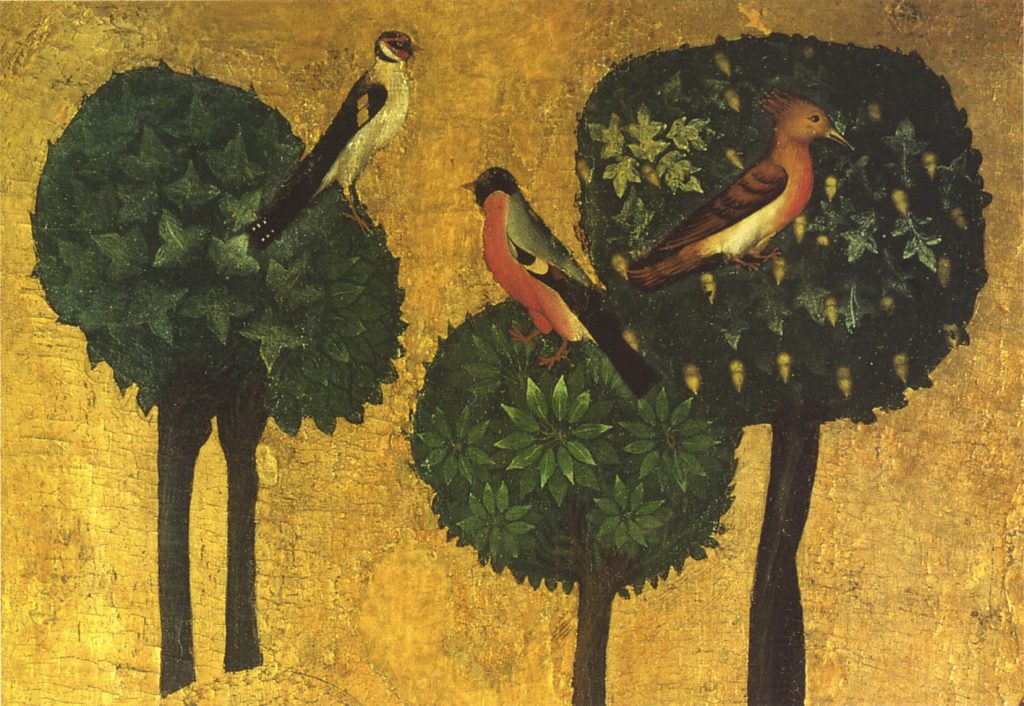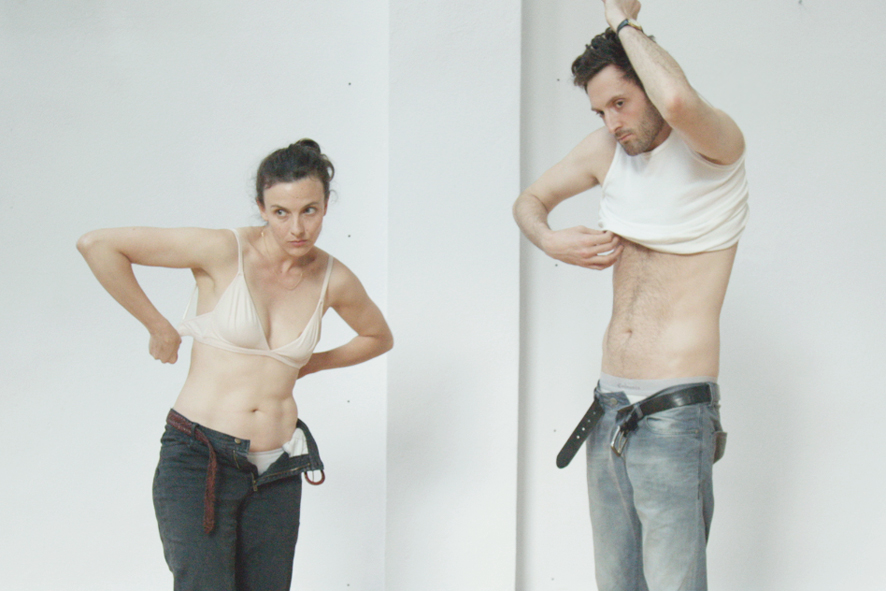Can the money we all use on a daily basis, be held responsible for the disastrous state the world is in today? In other words, if it is true that “money rules the world”, are we then not entitled to make it accountable for what has happened to the world under its governance? Trials of Money approaches this somewhat candid statement with the seriousness of a court of justice.
Agenda
Filter by artist
The focus of Sons of Sissy is the universe of traditions, folk dances and folk music from which the Upper Austrian country lad Simon Mayer originates.
What does it mean to be together? In Mazing, five dancers are set in motion by the audience, creating visible networks of action which emerge from simple social negotiations. This gently destabilizing performance both challenges and strengthens notions of community, re- affirming the power of touch in the digital age.
SunBengSitting is a piece straddling yodeling, folk dance and contemporary dance, a trip to the past and a playful, humorous search for identity.
The focus of Sons of Sissy is the universe of traditions, folk dances and folk music from which the Upper Austrian country lad Simon Mayer originates.
Works of science fiction give us an insight into a future civilization by telling the adventures of one of its individual inhabitants. Some use for your broken clay pots, on the contrary, provides us with the code that rules the life of the society it imagines.
According to Jewish legend, a golem is a figure made from dust or clay by a man of learning and brought to life by means of a ritual incantation. The golem was intended as an assistant to its human creator, as a companion or protector of the latter’s threatened community. But the experiment gets out of hand, and the creature turns against its creator.
Verein zur Aufhebung des Notwendigen is a dinner and it is about democracy. Not democracy as institutional engineering for mass organisation, but democracy as something we internalize, as individuals, at the level of our day to day existence. It is about democracy as the realisation of our individual and collective desires.
Andros Zins-Browne / The Great Indoors + Karthik Pandian
Atlas Revisited
In 2012, visual artist Karthik Pandian and choreographer Andros Zins-Browne visited the Atlas Film Studios in the desert of Ouarzazate, Morocco. There, in front of film sets from previous Hollywood productions, they hired a group of studio camels and tried to persuade them to dance. The result of this endeavor can be seen in their 2014 video Atlas/Inserts – a choreography that casts the camel both as a political animal and a technology of movement.
According to Jewish legend, a golem is a figure made from dust or clay by a man of learning and brought to life by means of a ritual incantation. The golem was intended as an assistant to its human creator, as a companion or protector of the latter’s threatened community. But the experiment gets out of hand, and the creature turns against its creator.
Look, Stefanie Claes and Bernard Van Eeghem speak with paint. At the far ends of their arms they are singing. Because everyone who stood in between them, has been long gone. Who still knows their names? Where are the roots of unknown angers hiding? Who interrogates the magma of the boiling lava swirling? Who spares the high viscosity? Who is made of wood? Who knows the distance? Who knows the resistance? Who who? That’s life. And it only lasts for a moment. Be there.
Works of science fiction give us an insight into a future civilization by telling the adventures of one of its individual inhabitants. Some use for your broken clay pots, on the contrary, provides us with the code that rules the life of the society it imagines.
In 2012, visual artist Karthik Pandian and choreographer Andros Zins-Browne visited the Atlas Film Studios in the desert of Ouarzazate, Morocco. There, in front of film sets from previous Hollywood productions, they hired a group of studio camels and tried to persuade them to dance. The result of this endeavor can be seen in their 2014 video Atlas/Inserts – a choreography that casts the camel both as a political animal and a technology of movement.
According to Jewish legend, a golem is a figure made from dust or clay by a man of learning and brought to life by means of a ritual incantation. The golem was intended as an assistant to its human creator, as a companion or protector of the latter’s threatened community. But the experiment gets out of hand, and the creature turns against its creator.
Spectacles is a research by Sara Manente starting from the distance between language and experience, specifically the experience of dance and performance.
Look, Stefanie Claes and Bernard Van Eeghem speak with paint. At the far ends of their arms they are singing. Because everyone who stood in between them, has been long gone. Who still knows their names? Where are the roots of unknown angers hiding? Who interrogates the magma of the boiling lava swirling? Who spares the high viscosity? Who is made of wood? Who knows the distance? Who knows the resistance? Who who? That’s life. And it only lasts for a moment. Be there.
Undertone is a choreography that focuses on the potentials of sensory perception of the audience. Stemming from the interest to challenge spectatorship and destabilize the convention of watching performance, Undertone invites the audience in a complete dark space to participate in an orchestration of fictional spaces. Hereby, the performance prioritizes mechanisms of perception other than vision by proposing an immersive experience of different kinds of stimuli.
Verein zur Aufhebung des Notwendigen is a dinner and it is about democracy. Not democracy as institutional engineering for mass organisation, but democracy as something we internalize, as individuals, at the level of our day to day existence. It is about democracy as the realisation of our individual and collective desires.
This is a dance of touch. The work exists in the active, tactile, engaged negotiation between performer and audience – in their tacit agreement and understanding. Arranged in an ellipse, the audience themselves form the bounds of the theatrical space. This is a journey that, by definition, performer and audience discover and create together.
Works of science fiction give us an insight into a future civilization by telling the adventures of one of its individual inhabitants. Some use for your broken clay pots, on the contrary, provides us with the code that rules the life of the society it imagines.
In Voicing Pieces, one’s own voice is staged to become the protagonist. In the intimacy of an isolated sound booth, guided by a simple score, the audience becomes spectator of their own voice.
Verein zur Aufhebung des Notwendigen is a dinner and it is about democracy. Not democracy as institutional engineering for mass organisation, but democracy as something we internalize, as individuals, at the level of our day to day existence. It is about democracy as the realisation of our individual and collective desires.
What does it mean to be together? In Mazing, five dancers are set in motion by the audience, creating visible networks of action which emerge from simple social negotiations. This gently destabilizing performance both challenges and strengthens notions of community, re- affirming the power of touch in the digital age.
Works of science fiction give us an insight into a future civilization by telling the adventures of one of its individual inhabitants. Some use for your broken clay pots, on the contrary, provides us with the code that rules the life of the society it imagines.
In As We Were Moving Ahead Occasionally We Saw Brief Glimpses of Beauty, Gaëtan Rusquet explores the choreographic potential of (live) video editing and the perspective of the selfie. In a never-ending tracking shot, the arm operates as a steadycam creating a hypnotic loop.
The focus of Sons of Sissy is the universe of traditions, folk dances and folk music from which the Upper Austrian country lad Simon Mayer originates.
Works of science fiction give us an insight into a future civilization by telling the adventures of one of its individual inhabitants. Some use for your broken clay pots, on the contrary, provides us with the code that rules the life of the society it imagines.
Bernard Van Eeghem is a theatre-maker, artist and writer. In Sanglier these activities are combined more than ever.
** nominated as ‘best performace’ for the “prix de la critique 2012” **
This durational performance is conceived as a public rehearsal, where choreographer Zins-Browne practices the remixing, overlapping, extending and warping of his own repertoire, attempting to ‘unmake’ a personal history of choreography.
The focus of Sons of Sissy is the universe of traditions, folk dances and folk music from which the Upper Austrian country lad Simon Mayer originates.
This durational performance is conceived as a public rehearsal, where choreographer Zins-Browne practices the remixing, overlapping, extending and warping of his own repertoire, attempting to ‘unmake’ a personal history of choreography.
A site specific performance of a slowly mutating image high in the sky. A striking intervention in public space.
Oh Magic wanders through the wonders of theatrical magic. It is that mysterious unnamable thing we sometimes have the chance to encounter in a piece. But, where does it come from and where does it take us? What fascinates us as a performer or as a spectator? Somewhere between freak and fascination, Simon Mayer and his performers seek for the answers both in technological manipulation and organic oracles.
In Voicing Pieces, one’s own voice is staged to become the protagonist. In the intimacy of an isolated sound booth, guided by a simple score, the audience becomes spectator of their own voice.
Verein zur Aufhebung des Notwendigen is a dinner and it is about democracy. Not democracy as institutional engineering for mass organisation, but democracy as something we internalize, as individuals, at the level of our day to day existence. It is about democracy as the realisation of our individual and collective desires.
Works of science fiction give us an insight into a future civilization by telling the adventures of one of its individual inhabitants. Some use for your broken clay pots, on the contrary, provides us with the code that rules the life of the society it imagines.
Verein zur Aufhebung des Notwendigen is a dinner and it is about democracy. Not democracy as institutional engineering for mass organisation, but democracy as something we internalize, as individuals, at the level of our day to day existence. It is about democracy as the realisation of our individual and collective desires.
SunBengSitting is a piece straddling yodeling, folk dance and contemporary dance, a trip to the past and a playful, humorous search for identity.
Look, Stefanie Claes and Bernard Van Eeghem speak with paint. At the far ends of their arms they are singing. Because everyone who stood in between them, has been long gone. Who still knows their names? Where are the roots of unknown angers hiding? Who interrogates the magma of the boiling lava swirling? Who spares the high viscosity? Who is made of wood? Who knows the distance? Who knows the resistance? Who who? That’s life. And it only lasts for a moment. Be there.
SunBengSitting is a piece straddling yodeling, folk dance and contemporary dance, a trip to the past and a playful, humorous search for identity.
Andros Zins-Browne / The Great Indoors + Karthik Pandian
Atlas Revisited
In 2012, visual artist Karthik Pandian and choreographer Andros Zins-Browne visited the Atlas Film Studios in the desert of Ouarzazate, Morocco. There, in front of film sets from previous Hollywood productions, they hired a group of studio camels and tried to persuade them to dance. The result of this endeavor can be seen in their 2014 video Atlas/Inserts – a choreography that casts the camel both as a political animal and a technology of movement.
The focus of Sons of Sissy is the universe of traditions, folk dances and folk music from which the Upper Austrian country lad Simon Mayer originates.
The focus of Sons of Sissy is the universe of traditions, folk dances and folk music from which the Upper Austrian country lad Simon Mayer originates.
The focus of Sons of Sissy is the universe of traditions, folk dances and folk music from which the Upper Austrian country lad Simon Mayer originates.
Works of science fiction give us an insight into a future civilization by telling the adventures of one of its individual inhabitants. Some use for your broken clay pots, on the contrary, provides us with the code that rules the life of the society it imagines.
SunBengSitting is a piece straddling yodeling, folk dance and contemporary dance, a trip to the past and a playful, humorous search for identity.
The focus of Sons of Sissy is the universe of traditions, folk dances and folk music from which the Upper Austrian country lad Simon Mayer originates.
In As We Were Moving Ahead Occasionally We Saw Brief Glimpses of Beauty, Gaëtan Rusquet explores the choreographic potential of (live) video editing and the perspective of the selfie. In a never-ending tracking shot, the arm operates as a steadycam creating a hypnotic loop.
The focus of Sons of Sissy is the universe of traditions, folk dances and folk music from which the Upper Austrian country lad Simon Mayer originates.
Gallop (Biography of a Body) tells the bizarre story of the life cycle of a body. It is a chronically ill body that has reached a turning point after forty years, and often seems to have a life of its own. Its service fails and resistance loses.
This is a dance of touch. The work exists in the active, tactile, engaged negotiation between performer and audience – in their tacit agreement and understanding. Arranged in an ellipse, the audience themselves form the bounds of the theatrical space. This is a journey that, by definition, performer and audience discover and create together.
SunBengSitting is a piece straddling yodeling, folk dance and contemporary dance, a trip to the past and a playful, humorous search for identity.
SunBengSitting is a piece straddling yodeling, folk dance and contemporary dance, a trip to the past and a playful, humorous search for identity.
Oh Magic wanders through the wonders of theatrical magic. It is that mysterious unnamable thing we sometimes have the chance to encounter in a piece. But, where does it come from and where does it take us? What fascinates us as a performer or as a spectator? Somewhere between freak and fascination, Simon Mayer and his performers seek for the answers both in technological manipulation and organic oracles.
Can the money we all use on a daily basis, be held responsible for the disastrous state the world is in today? In other words, if it is true that “money rules the world”, are we then not entitled to make it accountable for what has happened to the world under its governance? Trials of Money approaches this somewhat candid statement with the seriousness of a court of justice.
The focus of Sons of Sissy is the universe of traditions, folk dances and folk music from which the Upper Austrian country lad Simon Mayer originates.
The focus of Sons of Sissy is the universe of traditions, folk dances and folk music from which the Upper Austrian country lad Simon Mayer originates.
In Voicing Pieces, one’s own voice is staged to become the protagonist. In the intimacy of an isolated sound booth, guided by a simple score, the audience becomes spectator of their own voice.
What does it mean to be together? In Mazing, five dancers are set in motion by the audience, creating visible networks of action which emerge from simple social negotiations. This gently destabilizing performance both challenges and strengthens notions of community, re- affirming the power of touch in the digital age.
In Both, Two Tussing & Vanderbruggen examine the duet, the smallest unit of togetherness. The dance duet is a genre with a history. In their most familiar forms, duets reflect the range of possibilities for relating, which resonate within a certain cultural imaginary. In particular, they reveal common-sense attitudes towards who gets to move, how, and under what conditions.
What does it mean to be together? In Mazing, five dancers are set in motion by the audience, creating visible networks of action which emerge from simple social negotiations. This gently destabilizing performance both challenges and strengthens notions of community, re- affirming the power of touch in the digital age.
Oh Magic wanders through the wonders of theatrical magic. It is that mysterious unnamable thing we sometimes have the chance to encounter in a piece. But, where does it come from and where does it take us? What fascinates us as a performer or as a spectator? Somewhere between freak and fascination, Simon Mayer and his performers seek for the answers both in technological manipulation and organic oracles.
Meanwhile, is a work about bodies, architectures, and disasters. The performers are evolving in a set that could be an architectural model or installation. Constantly, they have to deal with a destruction’s threat on what they build. By playing with scales, the body within the space ranges from power to helplessness.
In Voicing Pieces, one’s own voice is staged to become the protagonist. In the intimacy of an isolated sound booth, guided by a simple score, the audience becomes spectator of their own voice.
What does it mean to be together? In Mazing, five dancers are set in motion by the audience, creating visible networks of action which emerge from simple social negotiations. This gently destabilizing performance both challenges and strengthens notions of community, re- affirming the power of touch in the digital age.
SunBengSitting is a piece straddling yodeling, folk dance and contemporary dance, a trip to the past and a playful, humorous search for identity.
This durational performance is conceived as a public rehearsal, where choreographer Zins-Browne practices the remixing, overlapping, extending and warping of his own repertoire, attempting to ‘unmake’ a personal history of choreography.
Spectacles is a research by Sara Manente starting from the distance between language and experience, specifically the experience of dance and performance.
What does nature say? To find out, Myriam Van Imschoot visited a zoo, used a tuning fork to listen to a motorway, discovered on walks in the woods birds that sound like chainsaws or can imitate the ringtones of mobile phones, saw crocodiles in Australia but couldn’t hear them…
In Voicing Pieces, one’s own voice is staged to become the protagonist. In the intimacy of an isolated sound booth, guided by a simple score, the audience becomes spectator of their own voice.
Meanwhile, is a work about bodies, architectures, and disasters. The performers are evolving in a set that could be an architectural model or installation. Constantly, they have to deal with a destruction’s threat on what they build. By playing with scales, the body within the space ranges from power to helplessness.
Oh Magic wanders through the wonders of theatrical magic. It is that mysterious unnamable thing we sometimes have the chance to encounter in a piece. But, where does it come from and where does it take us? What fascinates us as a performer or as a spectator? Somewhere between freak and fascination, Simon Mayer and his performers seek for the answers both in technological manipulation and organic oracles.
This is a dance of touch. The work exists in the active, tactile, engaged negotiation between performer and audience – in their tacit agreement and understanding. Arranged in an ellipse, the audience themselves form the bounds of the theatrical space. This is a journey that, by definition, performer and audience discover and create together.
Oh Magic wanders through the wonders of theatrical magic. It is that mysterious unnamable thing we sometimes have the chance to encounter in a piece. But, where does it come from and where does it take us? What fascinates us as a performer or as a spectator? Somewhere between freak and fascination, Simon Mayer and his performers seek for the answers both in technological manipulation and organic oracles.
Tactile Quartet(s) is an interactive piece that builds on Vera Tussing’s previous explorations of dance, tactility, and the sensory engagement of the audience. Four musicians play the American Quartet by Dvořák, a piece written in the late 1800 and belonging to the romantic period in music history.
The focus of Sons of Sissy is the universe of traditions, folk dances and folk music from which the Upper Austrian country lad Simon Mayer originates.
Oh Magic wanders through the wonders of theatrical magic. It is that mysterious unnamable thing we sometimes have the chance to encounter in a piece. But, where does it come from and where does it take us? What fascinates us as a performer or as a spectator? Somewhere between freak and fascination, Simon Mayer and his performers seek for the answers both in technological manipulation and organic oracles.
What does it mean to be together? In Mazing, five dancers are set in motion by the audience, creating visible networks of action which emerge from simple social negotiations. This gently destabilizing performance both challenges and strengthens notions of community, re- affirming the power of touch in the digital age.
This is a dance of touch. The work exists in the active, tactile, engaged negotiation between performer and audience – in their tacit agreement and understanding. Arranged in an ellipse, the audience themselves form the bounds of the theatrical space. This is a journey that, by definition, performer and audience discover and create together.
A Breath Cycle consist of an ever-changing corpus of performances who share ‘breathing’ as their main focus. Seven performances on breathing or wherein the breath takes a central role will be presented in A Breath Cycle. All of the performances are based on a protocol.
Spectacles is a research by Sara Manente starting from the distance between language and experience, specifically the experience of dance and performance.
Spectacles is a research by Sara Manente starting from the distance between language and experience, specifically the experience of dance and performance.
Oh Magic wanders through the wonders of theatrical magic. It is that mysterious unnamable thing we sometimes have the chance to encounter in a piece. But, where does it come from and where does it take us? What fascinates us as a performer or as a spectator? Somewhere between freak and fascination, Simon Mayer and his performers seek for the answers both in technological manipulation and organic oracles.
The focus of Sons of Sissy is the universe of traditions, folk dances and folk music from which the Upper Austrian country lad Simon Mayer originates.
